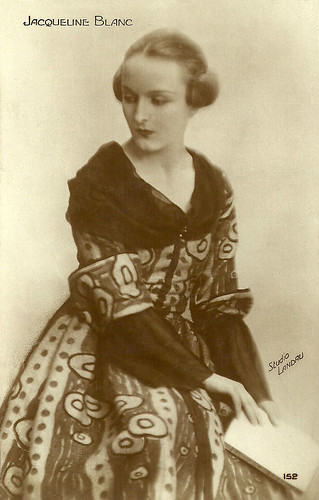
French postcard, no. 152. Photo: Studio Landau.
Hungarian photographer Ergy Landau (1896-1967), born in Budapest, was a friend of Moholy Nagy. She opened the Studio Landau in Paris in 1923. She is considered one of the pioneers in women photography. See also Wikipedia (French).
The great revelation
"Jacqueline Blanc is the great revelation of Mandrin", wrote Film magazine Mon Ciné in issue no. 109, 20-3-1924: "Everything indicates that this young artist has a brilliant film career before her." 1924 was the year of Blanc's film debut, but it would also be the year of her final film. However, it was a busy year with big roles in three films.
Her film debut was the period piece Mandrin/Mandarin (Henri Fescourt, 1924), a serial in 8 episodes produced by the Société des Cinéromans. In this serial, set in the mid-18th century, Romuald Joubé plays the title role of a French Robin Hood. Films on freedom fighters from around 1750-1850 were very popular in the French cinema of the mid-1920s, boosting national pride.
Jacqueline Blanc then appeared in the adventure film Surcouf (Luitz Morat, 1924). Surcouf was also a serial in 8 episodes with Jean Angelo in the title role as a pirate in the times of Bonaparte and William Pitt.
Then Blanc played the leading part of Blanche opposite Léon Mathot in Le diable dans la ville/The Devil in the City (1924) directed by avant-garde film-maker Germaine Dulac. Although the film is set in the fifteenth century and made with old-fashioned stock sets and costumes, it is much more than a period piece. Richard Abel argues in The Ciné Goes to Town that this is because of its cinematic rhythm, its social criticism and satire. The story is about a superstitious village, where the mayor has sold a tower to an unknown, who is soon suspected of being the devil.
And then Jacqueline Blanc's so promising film career suddenly halted. In fact, it was over before it really had begun. In 1925, Mon Ciné published on its cover (No. 161, 19-03-1925) a still of her in Surcouf. Nothing indicated that she would then vanish without a trace.
Sources: Richard Abel (The Ciné Goes to Town), Virtual History, DvdToile and IMDb.
This post was last updated on 3 June 2023.
No comments:
Post a Comment